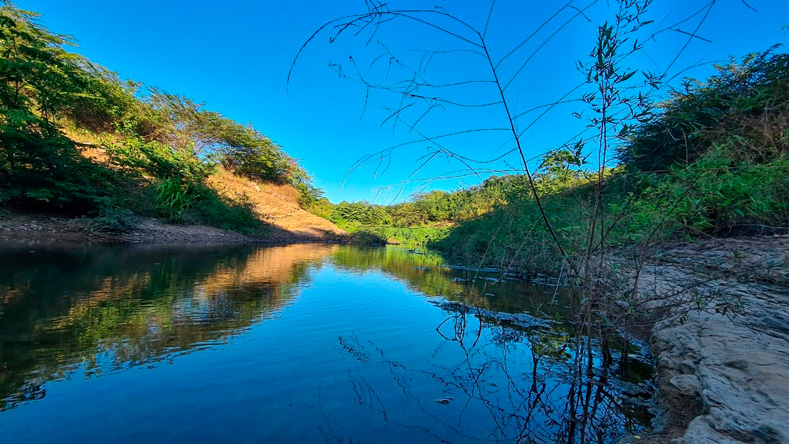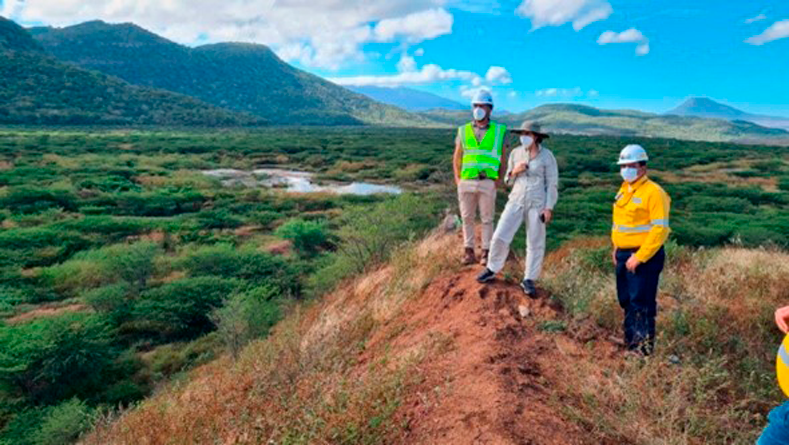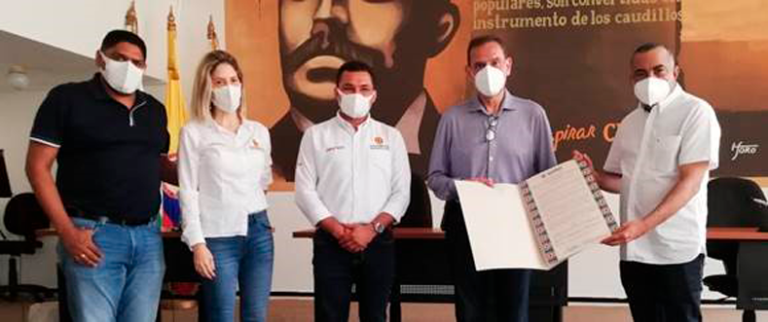E-Newsletter march 2021

Bruno Creek: four years later
After four years of learning and combined efforts from all the parties involved in the project to partially divert the Bruno Creek, important changes can be seen in the flora and fauna surrounding the creek. These include the creation of a large environmental corridor (which runs between the Montes de Oca forest reserve and the Ranchería River) and identification of more than 460 animals and plants.
Among the results found following partial diversion of the creek is that it still has had water in months during which there historically has been flow, a growing and gradual recovery of biodiversity that is seen in the identification of more than 390 species of animals along the new riverbed, and the growth of more than 12,000 trees such as the Uvito ( Cordia dentata), Ceiba Majagua (Pseudobombax septenatum), Mulato (Senegalia polyphilla), Guácimo (Guazuma ulmifoliaulmifolia), Trupillo (Prosopis juliflora) and the Majaguito (Muntingia zucurura), oak (Handroanthus impetiginosus), puy (Handroanthus billbergii), and ébano (Caesalpinia ebano). The latter is one of the key species for restoration given its ability to adapt to the new riverbed. Of the 12,000 trees, about 2,000 have grown naturally.
Among the plants identified, 21% are related to species that have arrived naturally to the riverbed thanks to dispersion of seeds through water, wind, or by the animals present in the creek, which demonstrate the creek’s good environmental evolution.
Through periodic monitoring of the behaviour of the stream, 154 types of insects, 120 of birds, 58 of amphibians and reptiles, 32 of fish, and 30 of mammals have been found. Among this, it is important to mention four jaguar sightings, including a cub, confirming the creek maintains ideal conditions so this species, an indicator of the ecosystem’s good conditions, can find shelter, water, and food.
In addition to these positive results in the creek’s behaviour, progress has been made in the compensation plan that was defined prior to the project’s development. Starting in October 2019, a plan was developed to protect the flora and fauna of the creek, which was agreed upon with the indigenous Wayuu communities of El Rocío and Tigre Pozo. This agreement, in addition to providing training and economic benefits to 37 families in the above-mentioned communities, looks to involve people in caring for this body of water’s origin through conservation activities at the El Dilubio and Santa Isabel properties as well as on the upper and middle basin of the Bruno Creek. Among conservation activities done by the community are: conducting forest inventories, reporting hunting, logging and/or fire activities to the authorities, reporting and recording wildlife sightings, restricting livestock access, and participating in sessions to collect seeds, among others.
Partial diversion of the Bruno Creek is key to the company’s sustainability and for thousands of jobs, as well as for the benefits that Cerrejón contributes to La Guajira and the country. This project was done in an environmentally responsible way and with the neighbouring communities, was consulted with the communities of Campo Herrera, La Horqueta, El Rocío and Tigre Pozo, and the information has been shared with more than 7,000 people.
On January 18, various environmental leaders and experts, nationally and internationally recognized for their work and efforts in conservation of Colombian flora and fauna, made a two-day visit to see Cerrejón’s operation and the project to partially divert the Bruno Creek. Julia Miranda, former director of the National Parks of Colombia, who accompanied the visits, said:“The Bruno Creek, with Cerrejón’s intervention, is absolutely admirable. The recovery of the creek bed is spectacular”
Cerrejón contributes to formation of biological corridor in the Colombian Caribbean

Cerrejón, in the spirit of contributing to the protection and care of the environment and strengthening the recovery of strategic ecosystems, such as tropical dry forest, has joined the partnership for Caribbean Biodiversity and Development, which brings together public and private Colombian organizations, by donating more than 25,000 hectares that will be used to form a biological corridor in the Colombian Caribbean.
Biological corridors play a key role in the connectivity of ecosystems, landscapes, and habitats. The corridors can be natural or modified, and in both the continuity of biological processes is guaranteed, which allows the conservation and dispersion of flora and fauna, thus playing a key role in contributing to the fight against climate change.
This alliance is made up of the Natural National Parks of Colombia, the Alexander Von Humboldt Institute, the Conexión BioCaribe program developed by the United Nation’s FAO, and the USAID Natural Wealth Program, among others.
During the next ten years, Cerrejón will work to strengthen the environmental connection between the Sierra Nevada de Santa Marta and the Serranía del Perijá through the planting of millions of trees and establishment of conservation agreements with the communities living in this area. The establishment of this corridor will facilitate transit and conservation of key species, such as the jaguar, serving as a bridge between areas of enormous ecological importance from North to South America.
These actions, done through programs to rehabilitate land that has been affected by mining and for environmental compensation, will provide protection for degraded and endangered ecosystems, such as tropical dry forest, as well as for threatened species.
We share some of the testimonies of recognized leaders and environmental experts, who visited the Cerrejón operation on January 18:
“Cerrejón, as a company, is an example and stands out for its effort at solidarity, focused on managing connectivity in fragmented areas in order to achieve the country’s goals and the sustainability of its territory”, Carlos Castaño, Director of the Herencia Ambiental Caribe (Caribbean Environmental Heritage) Foundation
“I’m impressed by the amount of information the tropical dry forest laboratory produces … the size of this plot allows the hypotheses to be substantiated immediately. I’m impressed with the effort being made and with the company’s contribution to the creation of knowledge”, Germán Corzo, Researcher from the Humboldt Institute.
La Guajira assembly acknowledges Cerrejón’s support during COVID-19 emergency

Cerrejón was publicly recognized by the Departmental Assembly of La Guajira for its contribution to managing the crisis caused by the COVID-19 pandemic. The Assembly stressed the good coordination between the Departmental Administration and the productive sector in optimizing resources aimed at reducing risks and increasing prevention, action, protection, and biosafety measures, safeguarding the lives of Guajirans and the inhabitants of the department.
“Today we present resolution 020 of 2021, by which the Assembly of La Guajira makes public recognition of the Cerrejón multinational for contributions facing the current crisis and for its social responsibility to the inhabitants of the department of La Guajira. Thank you very much to Claudia Bejarano Gutiérrez, president of the Cerrejón multinational, for her high level of commitment to the department of La Guajira. Thank you very much”, said Delay Magdaniel, Member of the Departmental Assembly.
To support La Guajira during the emergency, Cerrejón has invested USD 1.4 million in humanitarian assistance, translated into support for the health sector with the donation of the first molecular biology laboratory in the region, delivery of 100,000 medical supplies that have made it possible for professionals to have protective items for daily work, and delivery of three mechanical respirators and more than 400 pieces of equipment including stretchers and fetal or cardiac monitors, among other things, as well as the donation of 13,500 tests, between PCR and serological, for preventive analysis. As to community support, the company delivered more than 50,000 food bags (food/hygiene parcels), more than 29 million liters of drinking water, and protective items such as face masks and alcohol.
Cerrejón recently announced a donation to the La Guajira government of two ultralow-temperature freezers, to store COVID-19 vaccines, and an electric plant that guarantees permanent operation of the equipment and prompt availability of vaccines.

After four years of learning and combined efforts from all the parties involved in the project to partially divert the Bruno Creek, important changes can be seen in the flora and fauna surrounding the creek.
E-Newsletter march 2021
